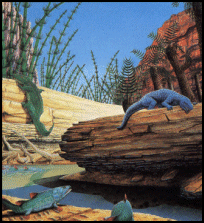Major Transitions in Biology
Science is the structuring of knowledge. It is the organization of knowledge such that knowledge can be tested, so that new varieties of knowledge can easily appear, so that knowledge can be archived and restored, so that knowledge can be communicated without grave error, so that knowledge can be built upon and extended. Most importantly, science is the method whereby knowledge is structured so that it can be structured further.
It is not necessary that science increase the “truthfulness” or volume of total information. It is only necessary that it increase the order, variety and organization of knowledge.
The history of science is the evolution of knowledge’s organization. The evolution of knowledge began with relatively simple organizations of information. The most simple organization was the invention of the “fact.” (The parameters of a fact were sorted out by the legal system in the mid-1500s in order to resolve what “evidence” was.) Over time, the methods by which knowledge could be organized increased in variety, as did the complexity of that organization. Today, the organization of knowledge within science is extremely layered, richly convoluted, and operates at many levels. The scientific method today bears little resemblance to the earliest attempts at science 400 years ago, before the advent of experiment, report, peer review and other inventions. As one example, the best medical research a hundred years ago did not rely on the type of rigorous double-blind experiments that we require for the most basic evidence of a successful remedy today.
The development of the technium is fundamentally the history of science and knowledge. I do not mean the history of scientific inventions, where one type of discovery is cataloged before the next. Chronologies of inventions, as fascinating as they are, don’t tell the underlying story of how this narrative of change reshapes itself. The underlying story is recursive. Knowledge was structured so that it could be structured yet again at another level; this bootstrapping propelled the advancement of science.
In many ways the evolution of knowledge in science more resembles the evolution of knowledge in a living organism, as it evolves and complexifies over deep time. Of the many ways in which a mammal differs from a sponge say, one of the primary differences is the additional layers in which information flows through the organism.
If we examine the major transitions in biology, we can arrange the story of life in several ways. One way is to chronicle spectacular biological transitions. In the list of life’s greatest gradual million-year passages would be such passages as when organisms migrated from the seas to land, or acquired backbones, or developed eyes, or the steady arrival of flowering plants, or the demise of dinosaurs, and the rise of mammals. These are important benchmarks in our past and legitimate achievements in our ancestors’ tale.
 But I believe the most revealing way to view the 4 billion-year history of life is to mark the major transitions in the informational organization of life’s forms. In this view biological organization means knowledge organization. To view its stages we need to call out the major transitions of structure over evolutionary time. This was the method of John Maynard Smith and Eors Szathmary who found eight thresholds of biological information organization in the 4 billion-year old history of life.
But I believe the most revealing way to view the 4 billion-year history of life is to mark the major transitions in the informational organization of life’s forms. In this view biological organization means knowledge organization. To view its stages we need to call out the major transitions of structure over evolutionary time. This was the method of John Maynard Smith and Eors Szathmary who found eight thresholds of biological information organization in the 4 billion-year old history of life.
They concluded the major transitions in biological organization were:
Replicating molecules –) Populations of molecules
Independent replicators –) Chromosomes
RNA as gene and enzyme –) DNA proteins
Prokaryotes –) Eukaryotes
Asexual clones –) Sexual populations
Protists –) Organism differentiation
Solitary individuals –) Colonies
Primate societies –) Language-based societies
Each level in their hierarchy indicates a major re-ordering of biological information. For example, the invention of sex is actually a major innovation in structuring genetic information. By permitting an ordered recombination of traits (some from each partner) rather than the pure random diversity of mutations, sex will maximize evolvability. Animals using sexual recombination of genes will evolve faster. The natural invention of multicellularity and of colonies of multi-cells are inventions that supply advantages in terms of Darwinian survival to organisms employing these designs, but more importantly these innovations are platforms that permit biological bits top be organized in new ways (one of which is to enable more evolution to occur). Multicellularity opens up a zillion new ways to organize matter and energy and to permit entirely new ways for things to evolve.


